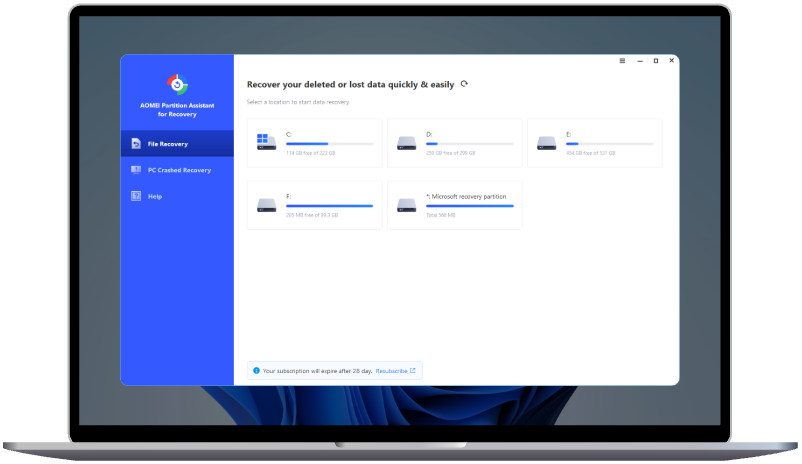Fixed: While Organizing Files You Accidentally Delete An Entire Folder
How to retrieve data while organizing files you accidentally delete an entire folder? Here are X ways allows you to recover permanently deleted folder or file on Windows 10 and 11.
Over time, your computer can fill up with junk or duplicate files. To free up space, you might delete some files. But sometimes, you might need to recover data while organizing files you accidentally deleted an entire folder. Losing important files can be very upsetting, especially if they can’t be recovered easily.
If this happens, it is important to stop to use your computer and act quickly for data recovery. Using your device might overwrite the deleted data, making it harder to recover. To avoid this, you should use good data recovery software. Now, let’s look at how to recover files you deleted by mistake and the best ways to get them back.
How to recover data while organizing files you accidentally delete an entire folder?
What should you do while organizing files you accidentally deleted an entire folder? Here are 4 simple methods allow you to easily and quickly restore lost data, even if the folders or files are permanently removed.
Method 1. Use AOMEI Partition Assistant for Recovery to recover permanently deleted folder and file
You don't have to worry if you remove anything important while organizing files you accidentally deleted an entire folder. AOMEI Partition Assistant for Recovery can help to recover more than 1000 file types, including Office 365 documents, pictures, videos, email files, and more.
This powerful software lets you recover unlimited data with a 99.7% success rate, even if folders are permanently deleted. It can handle complex data loss situations like disk formatting, system crashes, virus attacks, and more—all with just a few clicks.
The software supports file recovery from various devices, including hard drives, SSDs, USB flash drives, and pen drives. It is compatible with NTFS, FAT32, exFAT, and ReFS file systems on Windows 11/10/8/7 and Windows Server.
Step 1. Install and launch AOMEI Partition Assistant for Recovery. Choose the exact partition or disk where your data lost and click Scan.
Step 2. Then, the recovery tool start to scan and search. lt will execute the “Quickly Scan" first for finding your deleted data fast, and then execute the “Deep Scan" for searching other lost data.
Step 3. Once the scan is completed, all deleted files, recycle bins and other missing files will be displayed. Please select the file you would like to recover and then click "Recover".
Step 4. Then, select a folder path to save your recovered files.
Step 5. Wait patiently for this process of recovering ends.
Method 2. Retrieve a deleted folder with File History
Recent versions of Windows include a backup feature called File History. When turned on, it regularly backs up files from your Documents, Music, Photos, Videos, and Desktop files and folders.
File History saves files in small chunks, allowing you to restore older versions later. This means you can recover earlier copies of files, even if they were deleted a long time ago—almost like traveling back in time.
Step 1. Go to Control Panel > System and Security and click File History.
Step 2. Select Restore personal files. It will open the file history recovery window.
Step 3. Click the left arrow to locate your deleted files, and click the Restore to original location icon to restore deleted files from Recycle Bin.
Method 3. Recover an entire deleted folder from Backup and Restore
The Backup and Restore feature was first introduced in Windows Vista and Windows 7 and has remained in later versions of Windows because of its reliability. Many users still rely on it as their main backup tool, especially for recovering permanently deleted files on Windows 10.
This feature is not only great for recovering files but also allows you to create system image backups. This ensures you have a safeguard in case your operating system has trouble starting.
Step 1. Go to Control Panel > System and Security > Backup and Restore (Windows 7).
Step 2. Click Restore my files.
Step 3. Click Browse for files > Select photos you want > Next.
Step 4. Specify the destination to save your recovered photos and click Restore.
Method 4. Use CMD to recover accidentally deleted folder
How to retrieve a deleted folder? You can use the Command Prompt to recover lost data. Follow these steps to easily recover data while organizing files you accidentally delete an entire folder on Windows 10 and 11:
Step 1. Type Command Prompt in the Search icon or Start and Run as administrator.
Step 2. Input chkdsk [drive letter]:/f and tap the Enter key. Then, type Y and hit Enter to confirm and proceed to examine.
Step 3. Type in [drive letter] and hit Enter again. Then, enter attrib -h -r -s /s /d [drive letter]:\*.* to start recovering files on this disk.
Summary
This post helps you recover data while organizing files you accidentally delete an entire folder on Windows computers. If you accidentally delete important files or folders on your computer, you can recover them using a few simple methods. Acting quickly is important to avoid overwriting the lost data. You can use AOMEI Partition Assistant for Recovery, a tool that restores many file types with a high success rate, or try Windows features like File History or Backup and Restore to recover files from backups. Another option is to use the Command Prompt (CMD) to retrieve lost data manually. These methods make it easy to recover deleted files and folders.

